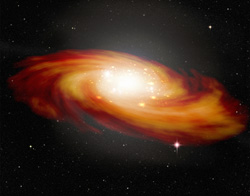Unveiling galaxy formation
The Epoch of Reionization refers to a period of the Universe – a few hundred million years ago – during which the gas in the Universe went from being almost completely neutral to an ionised state. A large amount of theoretical effort with little observational evidence has been devoted to understanding the processes that triggered this Epoch and have governed its evolution. Seeking to shed light on the picture of reionization, the EU-funded ‘Multifrequency tomography of the reionization epoch’ (Tomographyeor) project proposed to study the processes of galaxy mergers that lead to enhanced star formation. More specifically, scientists concentrated on evaluating stellar emission in star-forming galaxies, the joint ultraviolet (UV) and optical radiation of all the stars produced in the Universe, which constitutes a background collectively known as 'Extragalactic Background Light' (EBL). Using models that consider halo-merging history, the evolution of underlying dark matter, and stellar emission, scientists were able to study the contribution of merging galaxies to the EBL by calculating the mean intensity and angular fluctuations. They have also taken into account star formation histories, as well as dust extinction and the ability of UV-radiation to escape. Tomographyeor has combined theoretical studying with state-of-the-art numerical simulations to provide new perspectives on the role of star formation in the re-ionisation of the Universe. Results are expected to bring astrophysicists closer to understanding the mechanisms responsible for galaxy formation.



